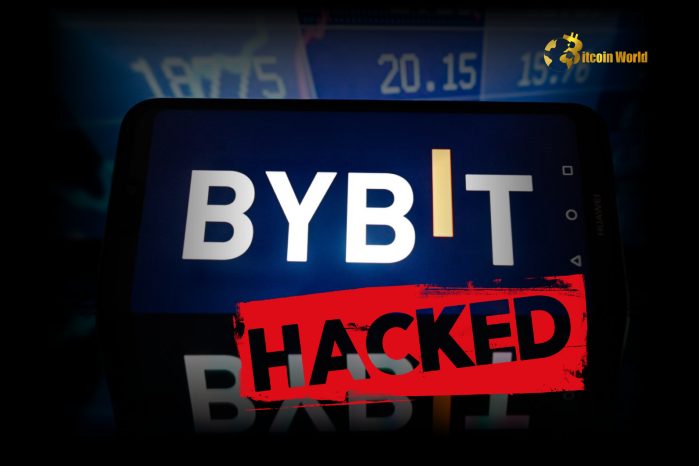
The ascent of stablecoins has reshaped the financial landscape, culminating in a $230 billion sector that commands over 1% of the US money supply. The recent integration of stablecoins by
CoinOtag
You can visit the page to read the article.
Source: CoinOtag
Disclaimer: The opinion expressed here is not investment advice – it is provided for informational purposes only. It does not necessarily reflect the opinion of BitMaden. Every investment and all trading involves risk, so you should always perform your own research prior to making decisions. We do not recommend investing money you cannot afford to lose.
Unraveling the Crypto Laundering Secrets of Lazarus Group: Years to Cash Out Stolen Funds

Ever wondered what happens to millions of dollars worth of cryptocurrency stolen by notorious hacker groups? It’s not as simple as just cashing it out and buying a fleet of Lamborghinis! Crypto expert Eric Wall recently shed light on the intricate and surprisingly lengthy process employed by North Korea’s Lazarus Group to launder their ill-gotten digital gains. Let’s dive into the fascinating, and frankly alarming, world of crypto laundering and how these cybercriminals operate. Decoding Lazarus Group’s Crypto Laundering Strategy According to crypto investor Eric Wall, the Lazarus Group, a hacking entity linked to North Korea, isn’t just grabbing crypto and running. They have a well-defined, multi-stage process to convert their stolen crypto into usable fiat currency. It’s like a digital obstacle course designed to obscure the origin of the funds. Here’s a breakdown of their laundering playbook: Step 1: ERC-20 Token Swap for Ether (ETH): Initially, many of the cryptocurrencies stolen are in the form of ERC-20 tokens, which operate on the Ethereum blockchain. The first step involves swapping these diverse tokens for Ether (ETH), the native cryptocurrency of Ethereum. This consolidation simplifies the holdings into a more liquid and widely accepted cryptocurrency. Step 2: Ether (ETH) to Bitcoin (BTC) Conversion: Next, the laundered Ether is converted into Bitcoin (BTC). Bitcoin, being the oldest and most dominant cryptocurrency, offers broader accessibility and liquidity across various exchanges globally. This step is crucial for further obfuscation and easier movement of funds. Step 3: Bitcoin (BTC) Cash Out via Asian Exchanges to Chinese Yuan: The final and perhaps most challenging step is cashing out the Bitcoin into traditional fiat currency, specifically Chinese Yuan. This is reportedly done through Asian cryptocurrency exchanges. This stage aims to convert the digital assets into a usable currency that can be accessed and utilized, presumably by the North Korean regime. Wall’s insights, shared on X (formerly Twitter), highlight the patience and persistence of the Lazarus Group . This isn’t a quick smash-and-grab operation; it’s a calculated, long-term strategy to extract value from their cyber heists. Why Does Crypto Laundering Take So Long? You might be thinking, “Years to cash out? In the fast-paced world of crypto?” Yes, years! And there are several reasons why crypto laundering , especially at this scale, is a marathon, not a sprint: Blockchain Transparency: While cryptocurrencies offer pseudonymity, blockchain transactions are transparent and traceable. Every transaction is recorded on a public ledger, making it possible for blockchain analysis firms and law enforcement agencies to track the flow of funds. Laundering efforts are all about trying to break or obscure this chain of traceability, which takes time and complex maneuvers. Exchange Scrutiny and KYC/AML Regulations: Cryptocurrency exchanges are increasingly under regulatory pressure to implement Know Your Customer (KYC) and Anti-Money Laundering (AML) procedures. Large or suspicious transactions can trigger red flags, leading to account freezes and investigations. Launderers need to navigate these regulations carefully, often using multiple exchanges and smaller transactions to avoid detection, slowing down the process significantly. Liquidity Constraints: Cashing out massive amounts of cryptocurrency, especially into fiat currency like Chinese Yuan, can be challenging without attracting attention. Exchanges have liquidity limits, and trying to offload huge sums quickly can depress the price and raise suspicions. Therefore, the process often involves smaller, incremental cash-outs over extended periods. Evolving Security and Tracking Technologies: The cryptocurrency industry is constantly evolving, with advancements in blockchain analytics and security measures. As tracking tools become more sophisticated, launderers need to adapt their techniques, leading to a cat-and-mouse game that prolongs the laundering timeline. The Chilling Example: Funds Stolen in 2016 Still Held in 2022 To underscore the protracted nature of this process, Eric Wall pointed out a stark example: North Korea was still holding onto funds stolen crypto in 2016 as late as 2022! This six-year gap vividly illustrates the immense time and effort involved in successfully laundering large sums of cryptocurrency. It’s a testament to the challenges even sophisticated cybercriminal organizations face in converting digital loot into usable assets. What Does This Mean for the Crypto World? The Lazarus Group’s meticulous and lengthy crypto theft and laundering operation has significant implications for the cryptocurrency ecosystem: Increased Security Awareness: It highlights the ongoing and evolving threat of state-sponsored hacking groups targeting the crypto space. Exchanges, DeFi platforms, and individual investors need to remain vigilant and continuously improve their security measures. Importance of Regulatory Compliance: The need for robust KYC/AML regulations within the crypto industry is further emphasized. While regulations can be burdensome, they are crucial in deterring and disrupting money laundering activities and maintaining the integrity of the crypto market. Advancements in Blockchain Analytics: The ability to track and trace stolen funds, even years later, demonstrates the growing sophistication of blockchain analytics tools. Continued development in this area is vital for law enforcement and security firms to combat crypto crime effectively. Long-Term Impact on Crypto Prices and Trust: Large-scale thefts and subsequent laundering attempts can impact market sentiment and potentially exert downward pressure on cryptocurrency prices, at least temporarily. Furthermore, it erodes trust in the security and stability of the crypto ecosystem if not addressed effectively. Can Lazarus Group Ever Be Stopped? Stopping a group like Lazarus Group is a complex international challenge. It requires a multi-pronged approach involving: International Cooperation: Cybercrime transcends borders, necessitating strong collaboration between law enforcement agencies worldwide to track, investigate, and prosecute these groups. Enhanced Cybersecurity Measures: Continuously improving cybersecurity defenses across the crypto industry is paramount. This includes strengthening exchange security, promoting secure wallet practices, and developing more resilient blockchain infrastructure. Sanctions and Financial Countermeasures: Governments can impose sanctions and financial restrictions to limit the Lazarus Group’s access to the global financial system and disrupt their funding sources. Blockchain Analytics and Intelligence Sharing: Leveraging advanced blockchain analytics and sharing intelligence about known laundering patterns can help identify and intercept illicit transactions more effectively. The Lingering Shadow of Crypto Theft The saga of Lazarus Group’s crypto theft and laundering activities serves as a stark reminder of the persistent threats in the digital asset landscape. While the transparency of blockchain offers tools to track illicit funds, the determination and sophistication of groups like Lazarus Group highlight the ongoing need for vigilance, innovation in security, and global cooperation to safeguard the cryptocurrency ecosystem. The years-long laundering process is a testament to both the challenges faced by cybercriminals and the slow but steady progress in combating crypto crime. To learn more about the latest crypto market trends, explore our article on key developments shaping Bitcoin price action. CoinOtag

Extreme Bitcoin DXY Correlation: Is This a Golden Opportunity or a Warning Sign?
Is the crypto market mirroring traditional finance more closely than we think? Recent analysis suggests a fascinating, and potentially critical, relationship between Bitcoin and the U.S. Dollar Index (DXY). According to Jamie Coutts, a respected analyst from Real Vision, the inverse correlation between Bitcoin and the DXY has reached extreme levels. This intriguing development could signal significant shifts in global liquidity and market dynamics, creating both opportunities and challenges for crypto investors. Let’s dive deep into what this means for your crypto portfolio and the broader market. Decoding the Bitcoin DXY Correlation: What’s the Hype? For those new to market analysis, understanding the Bitcoin DXY correlation is crucial. The DXY, or U.S. Dollar Index, measures the dollar’s strength against a basket of six major world currencies. Historically, Bitcoin, often seen as a hedge against traditional financial systems, has exhibited an inverse relationship with the DXY. This means when the dollar weakens, Bitcoin tends to rise, and vice versa. But why is this happening now, and why is it considered ‘extreme’? Jamie Coutts highlighted this unusual situation on X, noting that the current Bitcoin inverse correlation with the DXY is reaching levels rarely seen before. He suggests that while a weaker dollar is generally seen as favorable for risk assets like Bitcoin, political factors are currently exerting influence on the DXY. This creates a complex scenario that demands careful attention from investors. Why is the Inverse Correlation Between Bitcoin and DXY Important? Understanding this correlation offers valuable insights into broader market trends and potential investment strategies. Here’s why this relationship matters: Global Liquidity Indicator: A weakening dollar often signals increased global liquidity. When the DXY falls, it generally becomes cheaper for other countries to borrow and invest in dollar-denominated assets, including cryptocurrencies. Risk-On/Risk-Off Sentiment: A strong dollar often indicates a “risk-off” environment, where investors flock to the safety of the dollar. Conversely, a weaker dollar can suggest a “risk-on” sentiment, encouraging investment in riskier assets like Bitcoin. Investment Strategy Implications: Monitoring the DXY impact on Bitcoin correlation can help investors anticipate potential market movements and adjust their portfolios accordingly. An extreme correlation could indicate either an overextended market condition or an impending significant shift. To illustrate, consider a simplified scenario: DXY Trend Typical Bitcoin Reaction Market Sentiment DXY Decreases (Dollar Weakens) Bitcoin Price Tends to Increase Risk-On DXY Increases (Dollar Strengthens) Bitcoin Price Tends to Decrease Risk-Off Political Factors and the Dollar: What’s Influencing DXY? Coutts points out that political factors are playing a significant role in the current DXY dynamics. This is a crucial element to consider because traditional economic models might not fully capture the impact of geopolitical events on currency valuations. These political influences can include: Geopolitical Instability: Global events, such as conflicts or political uncertainty, can drive investors towards the perceived safety of the U.S. dollar, strengthening the DXY. US Fiscal Policy: Government spending and debt levels can influence investor confidence in the dollar. Aggressive fiscal policies might weaken the dollar over time. Federal Reserve Policy: Interest rate decisions and monetary policy by the Federal Reserve are primary drivers of dollar strength. Hawkish policies tend to strengthen the dollar, while dovish policies can weaken it. These political and economic factors are creating a tug-of-war, potentially contributing to the ‘extreme’ correlation observed. It’s not just about typical market forces; external pressures are adding layers of complexity to the DXY impact on Bitcoin . The Critical Level: 106 on the DXY Coutts specifically mentions the 106 level on the DXY as a critical threshold. He suggests that a drop below 106 would be a “strong bullish signal for global liquidity.” Why is this level so important? Technical Indicator: 106 likely represents a significant support level for the DXY. Breaking below this level could indicate a sustained weakening of the dollar. Liquidity Release: A weaker dollar, as discussed, typically translates to increased global liquidity. This liquidity often flows into various markets, including cryptocurrencies, potentially boosting Bitcoin’s price. Market Confidence: Breaching a key support level can also shift market sentiment. A DXY drop below 106 might instill greater confidence in risk assets and trigger further investment in Bitcoin. Therefore, keeping a close watch on the DXY, particularly around the 106 mark, is vital for anyone involved in the crypto market. This level could act as a key trigger for significant market movements and shifts in the Bitcoin DXY correlation . Navigating the Extreme Correlation: Actionable Insights for Crypto Investors So, what should crypto investors do with this information? Here are some actionable insights based on the current Bitcoin market analysis and the extreme DXY correlation: Monitor DXY Closely: Keep an eye on the U.S. Dollar Index, especially the 106 level. Use financial websites or trading platforms to track its movement in real-time. Diversify Your Portfolio: While Bitcoin shows a strong inverse correlation, diversification remains key. Don’t put all your eggs in one basket. Explore other cryptocurrencies and asset classes to mitigate risk. Stay Informed on Global Politics: Be aware of major geopolitical events and policy changes that could influence the dollar and, consequently, Bitcoin. Use Technical Analysis: Combine DXY analysis with other technical indicators for Bitcoin to make informed trading decisions. Look at Bitcoin’s price charts in conjunction with DXY movements. Manage Risk: Extreme correlations can sometimes revert to the mean. Be prepared for potential shifts in the relationship and manage your risk accordingly. Don’t overextend your positions based solely on this correlation. Is This Extreme Correlation a Golden Opportunity? The current crypto market signals are mixed but intriguing. While an extreme inverse correlation might seem like a straightforward bullish signal for Bitcoin if the DXY weakens, it’s essential to approach with caution. ‘Extreme’ conditions are often unsustainable and can be followed by sharp corrections or shifts in market dynamics. However, this situation also presents a potential golden opportunity. If Coutts is correct and a DXY drop below 106 unleashes significant global liquidity, Bitcoin could indeed see a substantial upward movement. The key is to be prepared, stay informed, and manage risk effectively. This period of extreme correlation could be a time of significant profit potential for those who understand and navigate it wisely. Conclusion: Riding the Waves of Correlation The extreme inverse correlation between Bitcoin and the DXY is a powerful reminder of the interconnectedness of global markets. Jamie Coutts’ analysis highlights a critical juncture where political factors and traditional market dynamics are converging to create unique opportunities and risks in the crypto space. By understanding the Bitcoin DXY correlation , monitoring key levels like 106 on the DXY, and staying informed about broader market influences, investors can better navigate these complex waters and potentially capitalize on the evolving market landscape. The current situation demands vigilance and informed decision-making, but for those prepared, the rewards could be substantial. To learn more about the latest crypto market trends, explore our article on key developments shaping Bitcoin price action. CoinOtag











